BY JANET
STEINBERG
STEINBERG
“In
Dublin’s fair city, where the girls are so pretty,
Dublin’s fair city, where the girls are so pretty,
I
first set my eyes on sweet Molly Malone…”
first set my eyes on sweet Molly Malone…”
Just
as the tragic ballad laments, there she stood greeting me at the top of Grafton
Street. In all her buxom bronze splendor, the 18th-century
fish-monger is still drawing a crowd to her wheel-barrow laden with cockles and
mussels. Immortalized in 1988 by sculptor Jean Rynhart, Molly Malone
has been affectionately, yet irreverently, dubbed by irrepressible Dubliners as
“The Tart with the Cart”.
as the tragic ballad laments, there she stood greeting me at the top of Grafton
Street. In all her buxom bronze splendor, the 18th-century
fish-monger is still drawing a crowd to her wheel-barrow laden with cockles and
mussels. Immortalized in 1988 by sculptor Jean Rynhart, Molly Malone
has been affectionately, yet irreverently, dubbed by irrepressible Dubliners as
“The Tart with the Cart”.
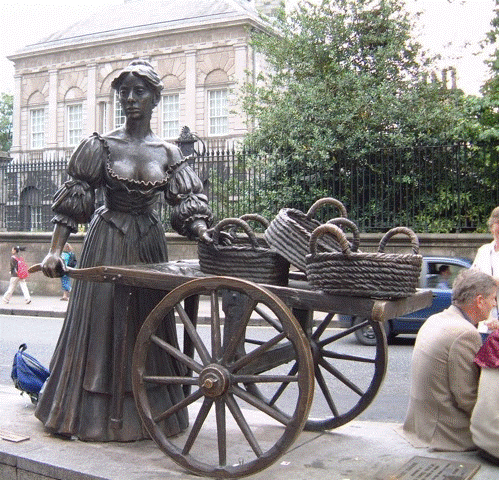 |
| MOLLY MALONE |
In
contrast, across the road from this provocative pushcart peddler, is the staid
campus of Trinity College. One of the main cultural, geographical,
and social hubs of the city, Trinity College was founded in 1592. You may
have to wait in line to view the illuminated, Middle Ages manuscript known as
“The Book of Kells”, but there is no wait to enjoy the splendor of the Henry
Moore and Calder sculptures on the campus lawns.
contrast, across the road from this provocative pushcart peddler, is the staid
campus of Trinity College. One of the main cultural, geographical,
and social hubs of the city, Trinity College was founded in 1592. You may
have to wait in line to view the illuminated, Middle Ages manuscript known as
“The Book of Kells”, but there is no wait to enjoy the splendor of the Henry
Moore and Calder sculptures on the campus lawns.
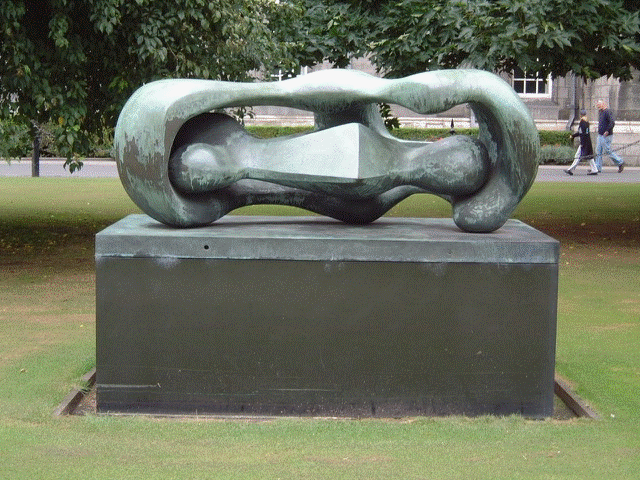 |
|
HENRY
MOORE ON TRINITY COLLEGE LAWN |
“Publand”,
as Dublin is called, is home to 1000 pubs and 1-million-plus people.
as Dublin is called, is home to 1000 pubs and 1-million-plus people.
One
might say that Dublin begins at the O’Connell Bridge that spans the Liffey
River. The Liffey flows through the center of town, separating the
northern part of the city from the southern side. Standing on the
O’Connell Bridge, in the shadow of Daniel O’Connell’s statue, one can
gaze down the river at the rainbow-arched Ha’penny Bridge. This
cast-iron pedestrian bridge, dating back to 1816, was officially named the Wellington
Bridge. Its nickname was derived from the half-penny toll that was once
charged to cross it.
might say that Dublin begins at the O’Connell Bridge that spans the Liffey
River. The Liffey flows through the center of town, separating the
northern part of the city from the southern side. Standing on the
O’Connell Bridge, in the shadow of Daniel O’Connell’s statue, one can
gaze down the river at the rainbow-arched Ha’penny Bridge. This
cast-iron pedestrian bridge, dating back to 1816, was officially named the Wellington
Bridge. Its nickname was derived from the half-penny toll that was once
charged to cross it.
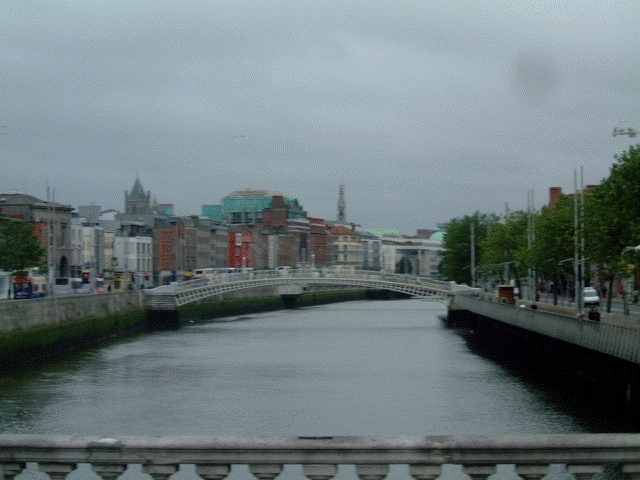 |
| THE ARCHED HA’ PENNY BRIDGE OVER THE LIFFEY RIVER |
In
the 18th and 19th century, elegant Georgian mansions were
built along the banks of the river. They soon stretched outward from the
banks of the river. Today, a favorite tourist pastime is photographing
the beautiful fan-arched doors of those mansions as they preen like peacocks
for the clicking shutterbugs. The area around Fitzwilliam Square
claims the most photographed door in Dublin.
the 18th and 19th century, elegant Georgian mansions were
built along the banks of the river. They soon stretched outward from the
banks of the river. Today, a favorite tourist pastime is photographing
the beautiful fan-arched doors of those mansions as they preen like peacocks
for the clicking shutterbugs. The area around Fitzwilliam Square
claims the most photographed door in Dublin.
 |
| GEORGIAN DOOR SAID TO BE THE MOST PHOTOGRAPHED DOOR IN DUBLIN |
The
18th century mansion at #1 Merrion Square was the
childhood home of Oscar Wilde from 1855-1878. This magnificent
Georgian home has been restored to its former glory and now houses the American
College of Dublin.
18th century mansion at #1 Merrion Square was the
childhood home of Oscar Wilde from 1855-1878. This magnificent
Georgian home has been restored to its former glory and now houses the American
College of Dublin.
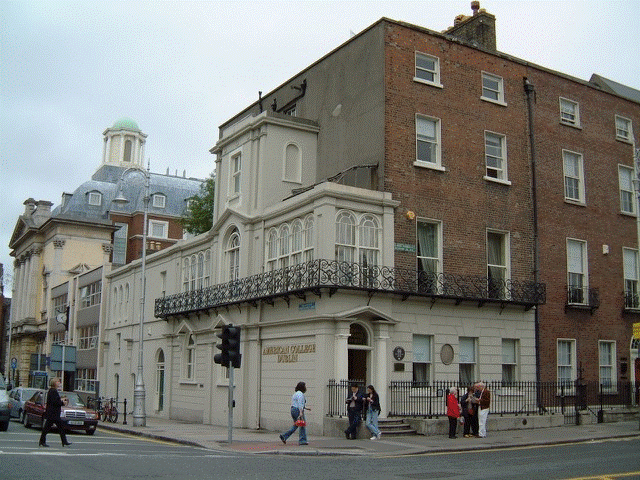 |
|
CHILDHOOD
HOME OF OSCAR WILDE |
Across
the street, in Merrion Park a lifelike sculpture of
Oscar Wilde reclines on a huge granite boulder. Pipe in
hand, this devilish Dubliner is clad in a pink and green smoking jacket, blue
slacks, black shoes, and silk socks so real looking that I had to touch them to
believe they were made of granite. And that’s no blarney!
the street, in Merrion Park a lifelike sculpture of
Oscar Wilde reclines on a huge granite boulder. Pipe in
hand, this devilish Dubliner is clad in a pink and green smoking jacket, blue
slacks, black shoes, and silk socks so real looking that I had to touch them to
believe they were made of granite. And that’s no blarney!
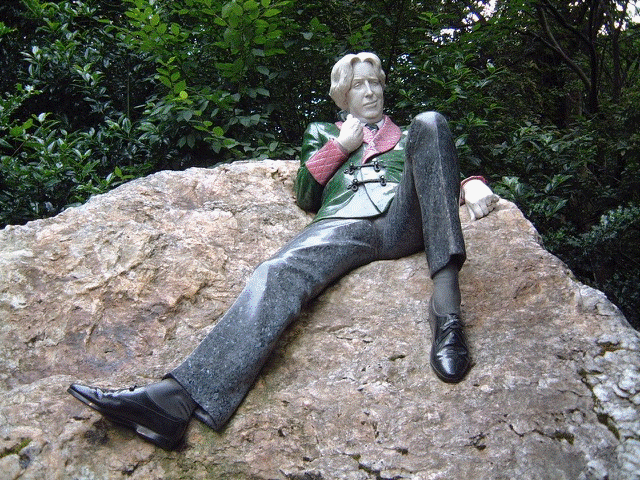 |
|
OSCAR
WILDE IN MERRION PARK |
For
what might well be Dublin’s best Fish and Chips, skip the pubs and head
for The Cellar Restaurant in the basement of The
Merrion Hotel, one of the city’s 5-star luxury hotels.The
Cellar Restaurant’s warm welcome is the perfect complement to a menu that
celebrates the best of Irish cuisine.
what might well be Dublin’s best Fish and Chips, skip the pubs and head
for The Cellar Restaurant in the basement of The
Merrion Hotel, one of the city’s 5-star luxury hotels.The
Cellar Restaurant’s warm welcome is the perfect complement to a menu that
celebrates the best of Irish cuisine.
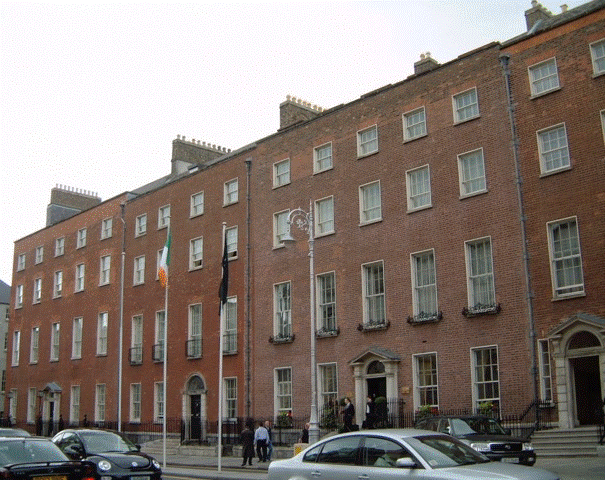 |
|
MERRION
HOTEL |
After
hundreds of years of darkness and silence, the rough stone walls of Lord
Mornington’s wine vault have come to life in the hotel’s Cellar Bar. The
bar’s arches echo with ripples of warm laughter, and the amiable staff will
“pull a proper pint” and teach you the difference between Guinness Stout and
Smithwick Ale (also brewed by Guinness).
hundreds of years of darkness and silence, the rough stone walls of Lord
Mornington’s wine vault have come to life in the hotel’s Cellar Bar. The
bar’s arches echo with ripples of warm laughter, and the amiable staff will
“pull a proper pint” and teach you the difference between Guinness Stout and
Smithwick Ale (also brewed by Guinness).
Opened
in October, 1997, the magnificent Merrion Hotel was created within four
lovingly restored 18th Century terrace houses opposite the seat
of the Irish Government on Upper Merrion Street. In fall and winter,
the air in the gracious Drawing Room is filled with the scent of woodsmoke and
flowers. Log fires crackle and sunbeams shine upon Belgian
tapestries, French chandeliers, and priceless Irish paintings. In spring
and summer the terrace is alive with ducks swimming to the music of water splashing
on the pebbles in the garden pools.
in October, 1997, the magnificent Merrion Hotel was created within four
lovingly restored 18th Century terrace houses opposite the seat
of the Irish Government on Upper Merrion Street. In fall and winter,
the air in the gracious Drawing Room is filled with the scent of woodsmoke and
flowers. Log fires crackle and sunbeams shine upon Belgian
tapestries, French chandeliers, and priceless Irish paintings. In spring
and summer the terrace is alive with ducks swimming to the music of water splashing
on the pebbles in the garden pools.
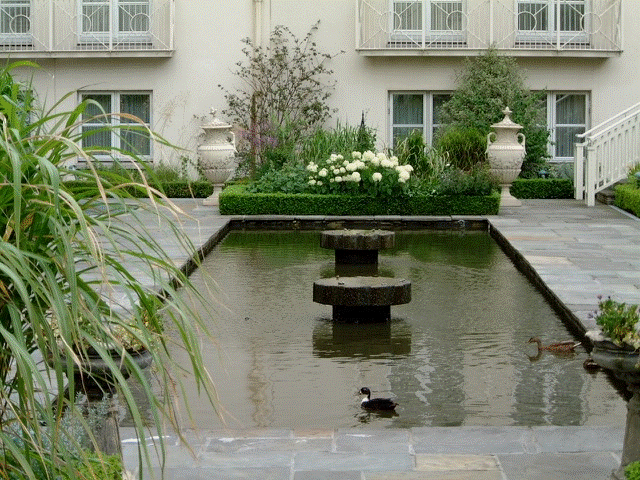 |
| DUCKS SWIM IN GARDEN POOL AT MERRION HOTEL |
From
the hotel’s garden, the scent of lilac and jasmine in the air drifts through
the open windows of Restaurant Patrick Guilbaud, the most renowned
kitchen in Ireland.
the hotel’s garden, the scent of lilac and jasmine in the air drifts through
the open windows of Restaurant Patrick Guilbaud, the most renowned
kitchen in Ireland.
 |
| MERRION HOTEL GARDEN |
With
the luck of the Irish, you will be able to leave lots of green shopping on the
Emerald Isle. Brown Thomas on Grafton Street, Royal
Hibernian Way, and St Stephens Mall, are good
for starters. Look for Bellek Porcelains, Royal Tara China,
Waterford Crystal, hand-woven tweeds and Irish linens. And don’t
forget a leprechaun or two.
the luck of the Irish, you will be able to leave lots of green shopping on the
Emerald Isle. Brown Thomas on Grafton Street, Royal
Hibernian Way, and St Stephens Mall, are good
for starters. Look for Bellek Porcelains, Royal Tara China,
Waterford Crystal, hand-woven tweeds and Irish linens. And don’t
forget a leprechaun or two.
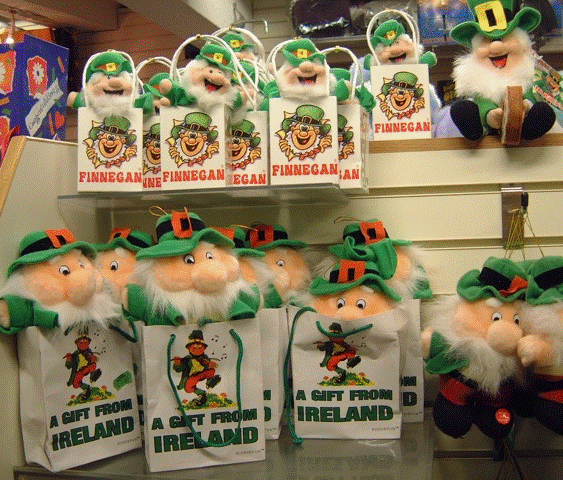 |
| DON’T FORGET A LEPRECHAUN OR TWO |
Bye
for now. It’s time for me to savor an Irish coffee.
for now. It’s time for me to savor an Irish coffee.
JANET STEINBERG is an
award-winning Travel Writer, International Travel Consultant, and winner of 40
national Travel Writing Awards.
award-winning Travel Writer, International Travel Consultant, and winner of 40
national Travel Writing Awards.
